UK outdoor gear stalwart Berghaus is best known for its high-performance mountain clothing. It’s a brand that has long been associated with British climbing royalty, with the likes of Chris Bonnington, Mick Fowler, Anna Taylor and Leo Houlding among its sponsored athletes.
However, the brand has forged a very solid reputation in the world of family camping, too. Its excellent family tents are available in the major high street camping retailers and its inflatable options have become renowned for their quality.
The Air 400 Nightfall Tent is its standard four-person air tent for camping families. It’s the little sibling to the larger Air 400XL, a grand shelter that’s ideal for week-long camping holidays.
This standard Air 400 model is the smallest in Berghaus’ air tent range and is ideally sized for weekends away. According to the brand, the shelters in the Air Tent range have been redesigned “to offer up to 20% more living space” than previous iterations thanks to the steeper walls brought about by the air beams.
The tent assumes its tunnel shape thanks to a trio of beams, which replace traditional tent poles. They provide the shelter with its structure and stability, while making it dead easy to pitch with the included pump.
In short, this is a quality family shelter that’s both easy to use and is usually available at a very reasonable price, way below its stated RRP.
Pros
- Super quick to set up and pack down
- Excellent stuff sack with wheels
- Bright living space, dark bedrooms
Cons
- Not the largest 4-person option
- Bedrooms could be wider
| RRP: | £1,050 |
| Weight: | 20.5kg / 3st 3.2lb |
| Packed size: | 80 x 46 x 39cm |
| Internal dimensions: | 495 x 280cm |
| Internal peak height: | 200cm |
Shape, structure, pitching and internal liveability
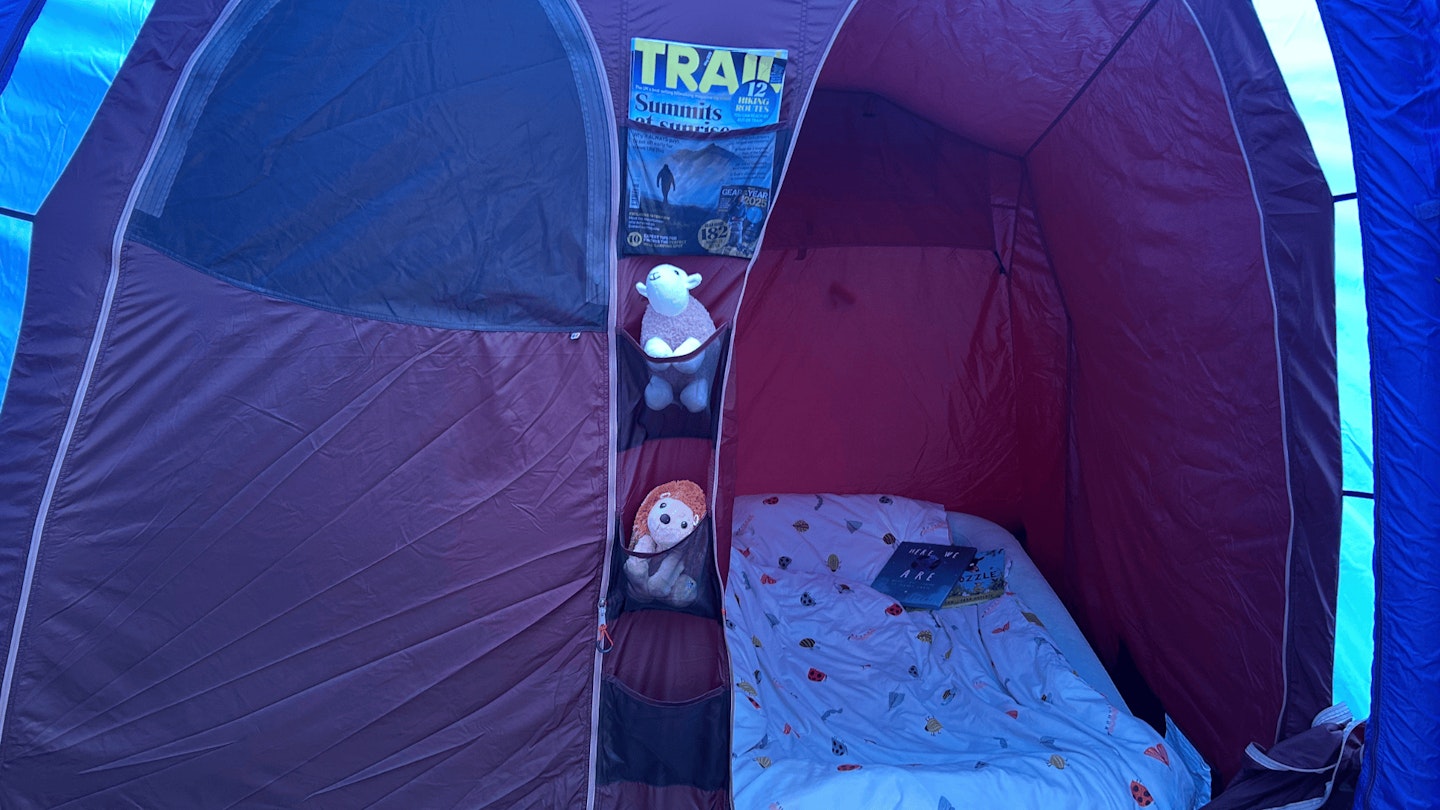
The Air 400 Nightfall is a classic tunnel tent with darkened bedrooms, a modest living space and a porch area. It uses three inflatable air beams to spring into shape, two of which form arches 200cm tall, thus providing plenty of headroom.
The third arch rises to 175cm and props up the sloping roof of the bedroom. Berghaus asserts that these beams are of ‘superior quality and strength’ to the competition – though short of overinflating every tent that I tested until their beams literally burst, I didn’t have means to test this claim.
As well as the three main air beams, the Air 400 also sneaks another little beam into the porch awning – a neat little innovation. I found that, of all the air tents I tested, this was the easiest and quickest to pitch.
As is standard for these kinds of air tents, all I had to do was peg out the corners and get to work pumping up the primary air beams to get it into a habitable shape.
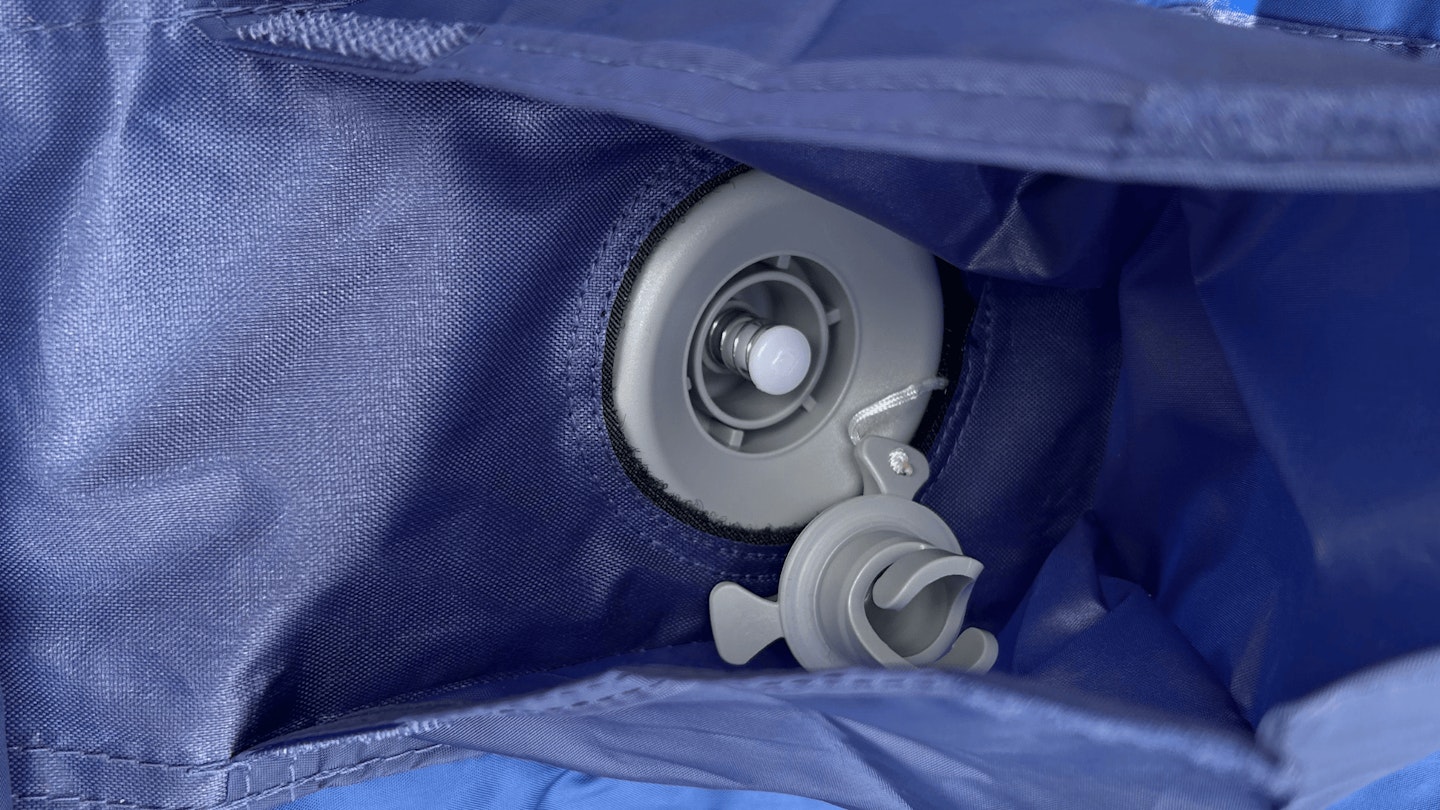
The main beams boast the same excellent, spring-loaded valve system as seen in Outwell’s Colorado 5 Air and the Hi Gear Lavvu Airlite. This two-way opening makes for quicker pitching than the usual alternatives.
You just have to remember to press the central button so that the spring is fully extended before inflating, otherwise all the air will rush back out when you remove the pump – an easy mistake to make.
When it comes to deflation, all I had to do was press the central button to release the air. The pump is fairly standard, with a pressure gauge and two-way stirrup.
Berghaus doesn’t boast about how long the tent takes to setup, which they really should as I found this was the quickest family air tent to pitch on test. I had it habitable, meaning corners pegged out and beams all inflated, in eight minutes and fully operational, with guylines tensioned and everything, in just 23 minutes.
The kids will still be checking out the playground at the campsite long after your castle of canvas is up, giving you a bit of spare time to brew up and breathe in the country air.
I was also able to pack the tent down, often a depressing task at the end of a lovely camping trip, in just over 11 minutes.
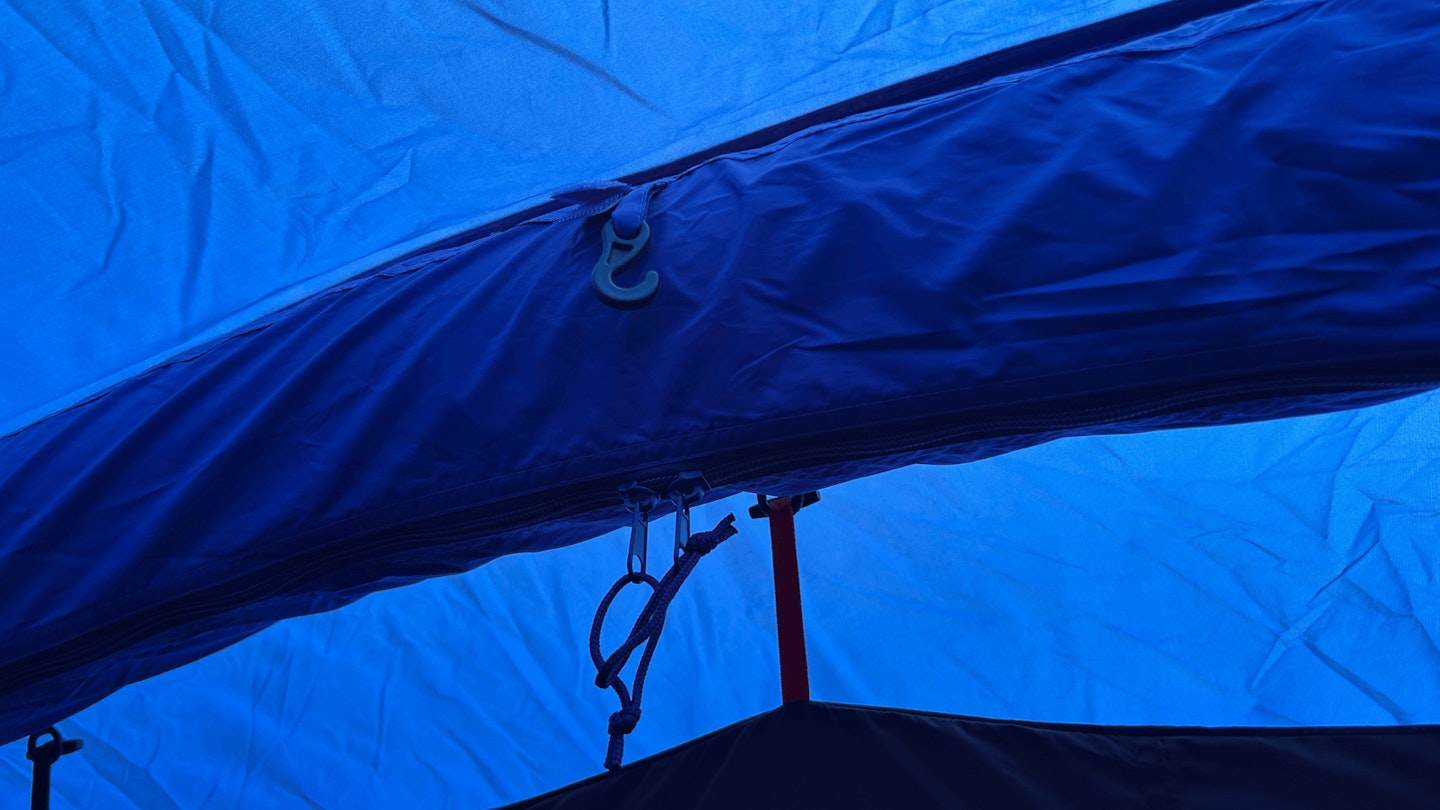
It's the steep U-shape of the beams that provides the additional space compared to the brand’s previous air tents, which featured shallower arches. The living area is a decent size (280 x 275cm) for four but isn’t as spacious as larger family tents designed for longer camping trips.
It’s not as wide as something like the Outwell Colorado 5 Air, at 280cm as opposed to 320cm. However, the ceiling is an impressive 200cm which, along with the steeper walls brought about by the new design, makes it a comfortable space for most people to stand up in.
On a nice day, this living area is a relatively bright place to be thanks to the number of windows, with two on either side of the main door, one in the side door and a large rectangular window on the opposite wall.
The striking Berghaus blue of the flysheet does give everything a bit of a blue tint when the sun is beaming down on it – so don’t be alarmed if your children suddenly look a little bit Smurf-like while you’re in there.
If you’re after a bit of a glamping vibe, Berghaus sells an additional carpet too, transforming the living area into something a little more refined, as well as a strict no-go for shoes, kids.

The bedroom area is split into two blacked-out pods with large, ovular doors. While they look like two separate spaces, in reality there’s merely a sheet of removable fabric between the two, so there’s nothing to stop excited kids jumping through the divide in the morning.
Likewise, when it’s Helvellyn-hike-day, there’s nothing to stop excited parents jumping in to wake the kids, too.
The Nightfall in the tent’s name refers to the blackout fabrics used on the bedrooms, which are very good but not as impressively dark and cool as the Fresh & Black fabrics seen in Quechua’s 4-Man Inflatable Camping Tent.
If you want, you can unclip the entire bedroom area to open up the main space further. The bedrooms aren’t huge, with a width of around 135cm to play with, enough for some double mattresses, but not all.
Waterproofing

Of all the inflatable tents in our recent roundup, none boasted such a protective flysheet as the Air 400. Berghaus states an impressive hydrostatic head (HH) rating of 6,000mm – in theory enough to halt pretty much anything Blighty’s weather gods can conjure.
To put this HH rating – in essence the amount of water pressure the fabrics can withstand – into context, most of the backpacking tents we’ve tested have an HH of less than 3,000mm – and these are tents that are designed for the mountains!
As the old adage does, HH isn’t everything – well, it’s an adage in outdoor gear circles anyway. Other factors are at play when it comes to repelling the drink, such as the tent’s shape, as well as the fabric’s water-repellent coating and its taped seams.
As you’d expect, the Air 400 has both of these, while its sloped shape allows water to run off effectively, with no saggy regions where water can pool. I didn’t doubt its water repelling qualities while on test and it didn’t let me down. For further protection, there’s also the option of the additional groundsheet protector.
Condensation

Unlike some large family tents, the Air 400 Nightfall has a sewn-in groundsheet. This is good in that little beasties can’t raid the tent but does make the tent less airy and could lead to ventilation issues. To combat this, there are various other vents across the tent.
As is standard in these sorts of tents, there’s a large opening behind the bedrooms that can be tensioned with guylines. The main and side doors feature two layers, one mesh and one the standard waterproof flysheet fabric.
The mesh option allowed me to keep airflow in play while keeping ticks, midges and other unwanted guests at bay. There’s also mesh above the windows on either side of the main door.
All of this made for a shelter that coped well at night – I found that condensation was not an issue when the vents were employed as designed.
Wind protection
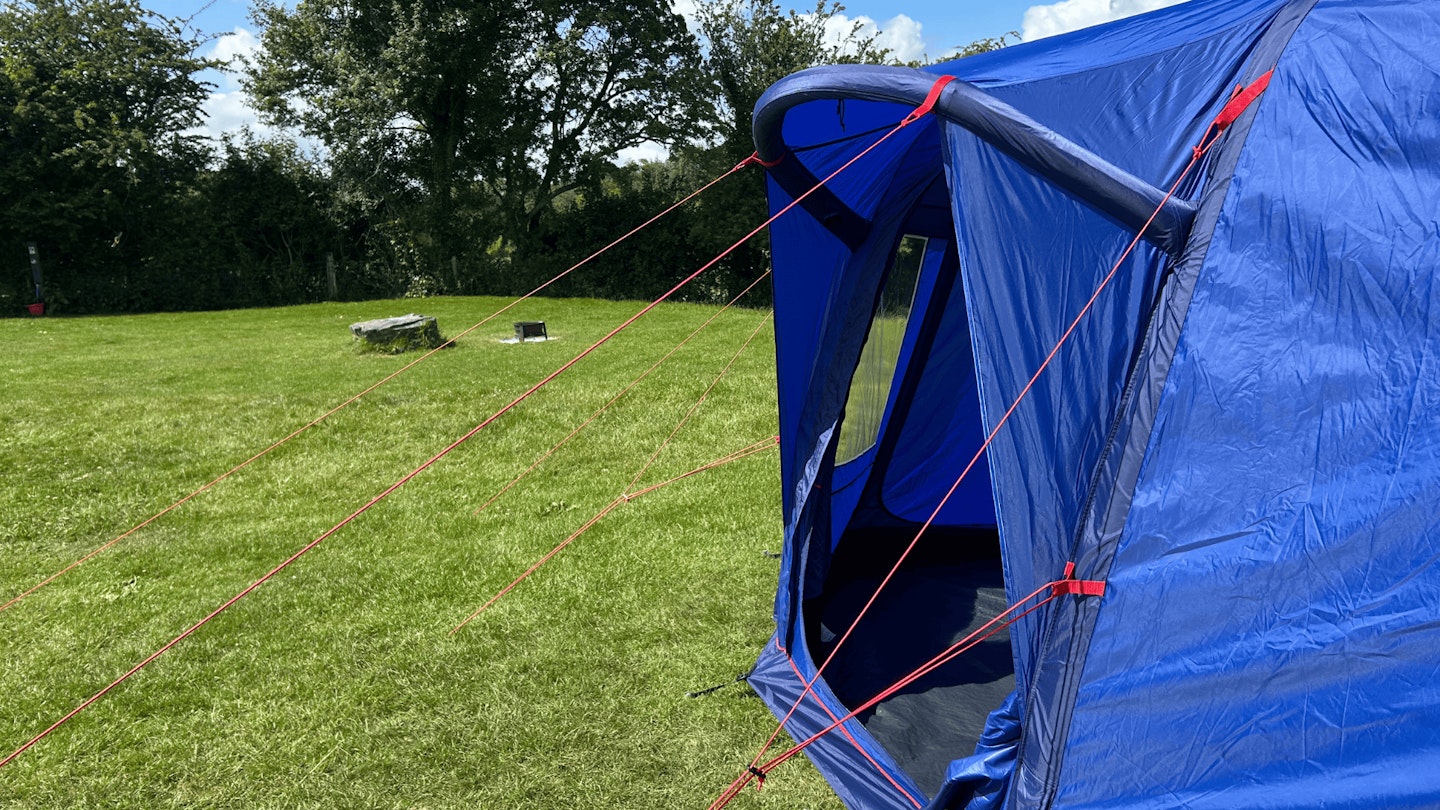
The Air 400 Nightfall has several features that help stand strong in the face of high winds. Firstly, its sloped sides encourage wind to flow over and around it, rather than into it – a phenomenon that anyone who’s stood in a col between two steep-sided hills will appreciate.
Next, there’s the fact that it’s not a particularly large air tent, so there’s not a huge amount of surface area for the wind to catch. Then, there are its guylines, anchoring the structure to the ground and helping it to maintain its shape.
An important factor to consider when it comes to air tents is that if the beams are pulled out of shape, the structural stability becomes compromised – something to bear in mind when tensioning the guylines.
Weight and packed size
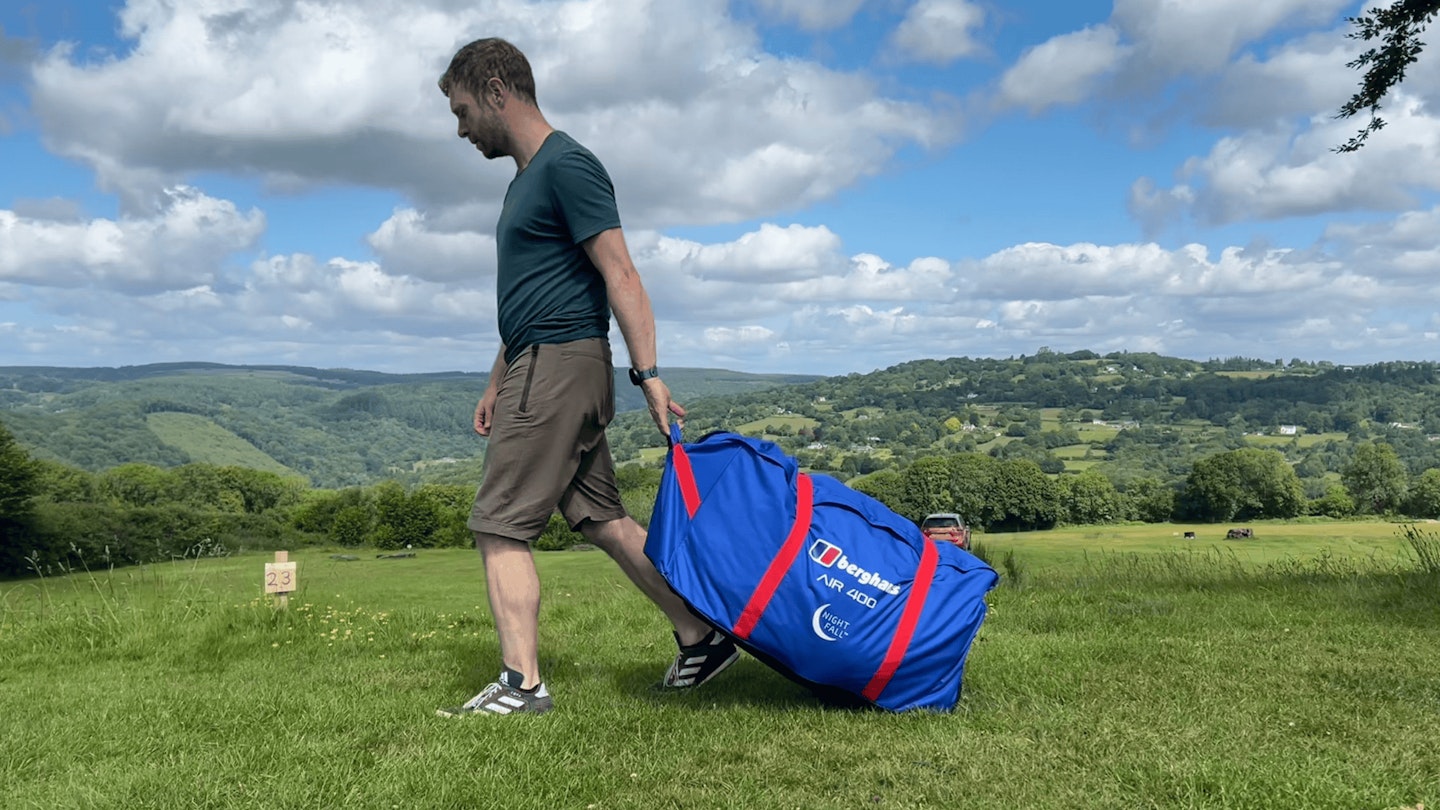
Weighing in at 20.5kg, the Air 400 Nightfall is heavy for your average four-person tent but not particularly so for a family shelter with multiple rooms. It’s just about light enough for a one-person carry. Handily, the carry bag comes with small wheels for easy transportation, so I never had to carry it very far.
When packed down, the whole unit measures 80 x 46 x 39cm, which isn't terrible, but some larger tents pack down slightly smaller.
The wheels on the carry bag are smooth on relatively flat surfaces, though I wouldn’t want to drag it across heathery, boulder-strewn ground, that’s for sure.
However, it wheels smoothly along grassy, accommodating campsite terrain, making it the most transportable family tent I’ve tested.
The design of the carry bag is also a strong point. A U-shaped zipper enabled me to almost fully open it up – ideal for dropping the tent into.
I still had to give it a bit of a wiggle and work the sides of the bag upwards to encourage the tent into its embrace before doing up the zipper, but the process was less fraught than most.
Features
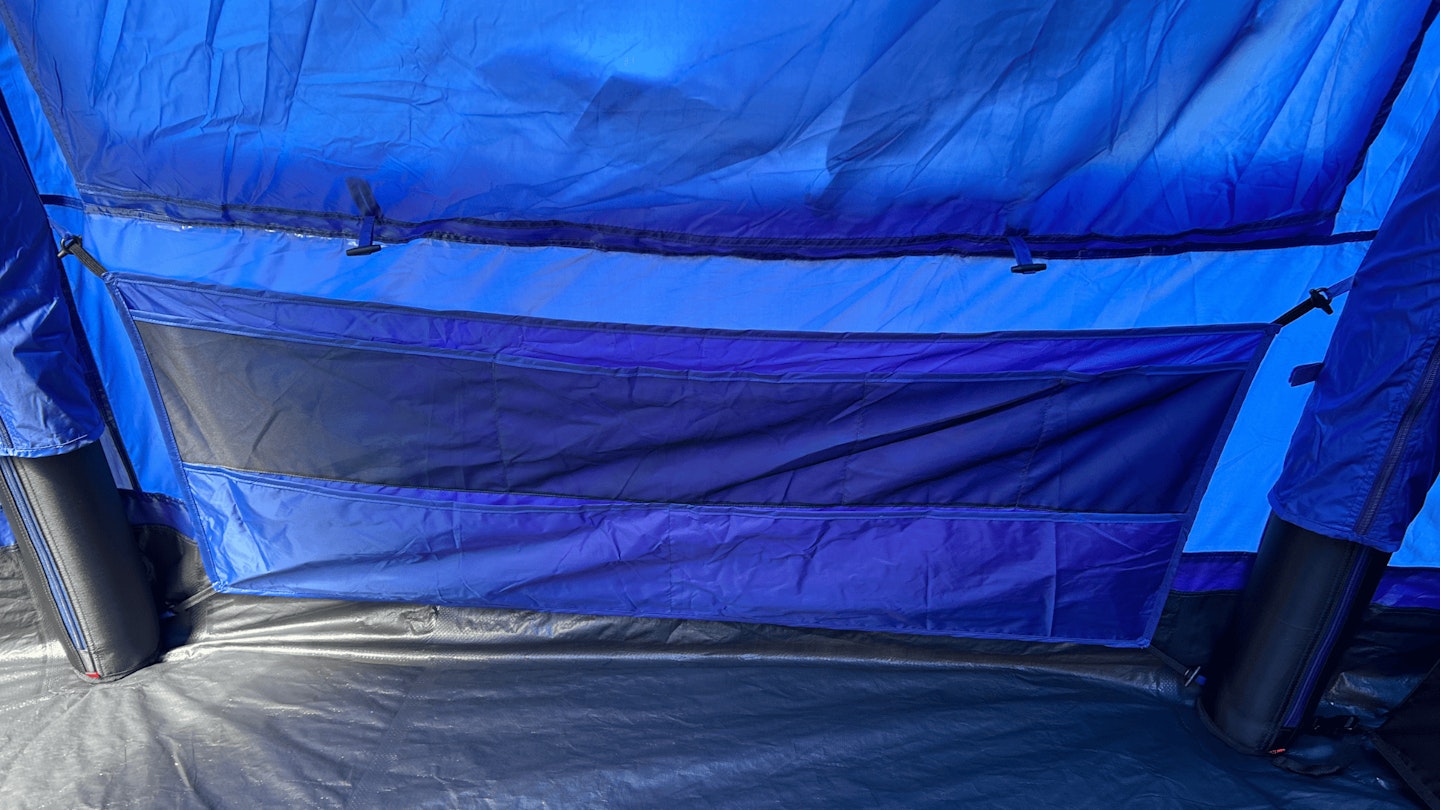
This is a well-featured tent with everything you need and little of what you don’t. It doesn’t quite have the same number of innovative touches as the Outwell Colorado 5 Air but then it’s a less fussy tent that’s easier to work with.
If you want a larger, premium shelter that takes a little more effort to put up and take down, the Colorado 5 Air is the better shout and a good one for longer trips. For an easier life without sacrificing too much on quality, the Air 400 is the one.
Of course, if you want extra space, there’s always the XL version to consider, while Berghaus also sells an additional porch unit, markedly increasing the overall footprint.
Storage isn’t an issue – Berghaus has included little compartments on the fabric wall between the bedroom doors, in the bedrooms themselves and on a side panel along the living room wall. This enabled me to keep my headtorch, phone, keys, magazines and my daughter’s toys (Lego’s no fun to stand on) off the ground.
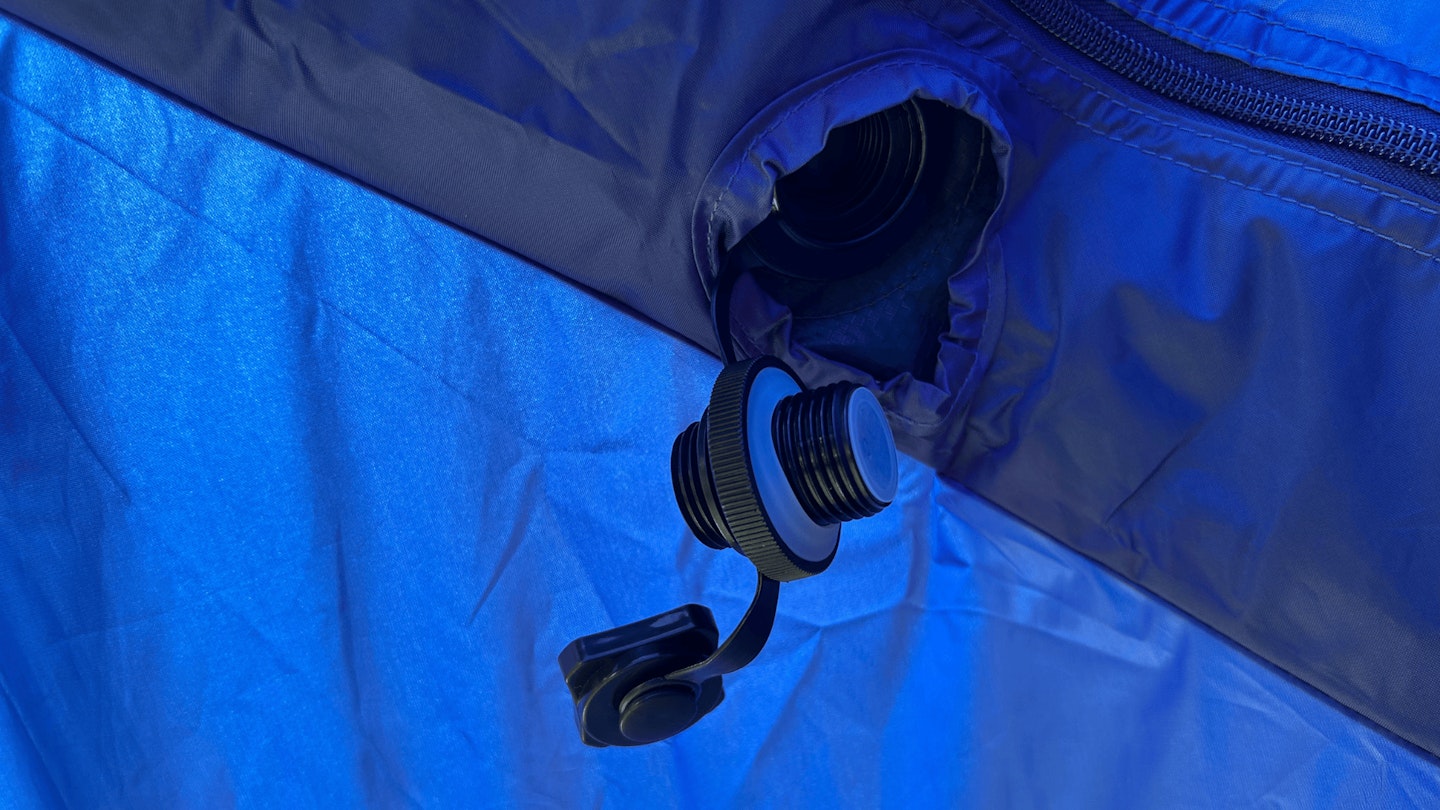
The inflatable porch awning is a nice little touch. On many family inflatable tents, these kinds of features revert to a traditional pole. Here Berghaus has demonstrated that you can use air beams throughout the structure.
The little beam features the same two-way screw valve as seen on the Quechua 4-Man Inflatable Blackout Tent and the Eurohike Genus 800, as opposed to the spring-loaded valve that the main air beams use here.
For all your electrical camping gadget needs, there are two discreet access points for power – one under the side door and then other on the opposite wall of the living space. The central beam features Velcro cable tidies to keep wires off the ground, as well as a handy lantern hook.
Final verdict

This is a great family air tent, with a design that makes life easy – which is half the battle on a camping trip with your tribe. Of all the family air tents I’ve tested, this is the quickest and most straightforward to both pitch, pack away and transport.
It’s also well-featured, bright in the living room and dark in the bedrooms. It’s not quite as spacious as some, so is better for shorter trips than weeks-long holidays, but for a solid all-rounder, it’s hard to beat. Overall, we'd rate it at an 81% out of 100.
If you're looking for a solo venture after spending so much time with your family, check out our roundup of the best wild camping tents.
Shop this product
About the author

As a qualified Mountain Leader, avid wild camper and a family man, Alex enjoys camping in all its forms. An expert on all things outdoor gear, he’s been testing and reviewing camping kit and tents – from solo backpacking shelters to palatial family car camping tents – for many years.



